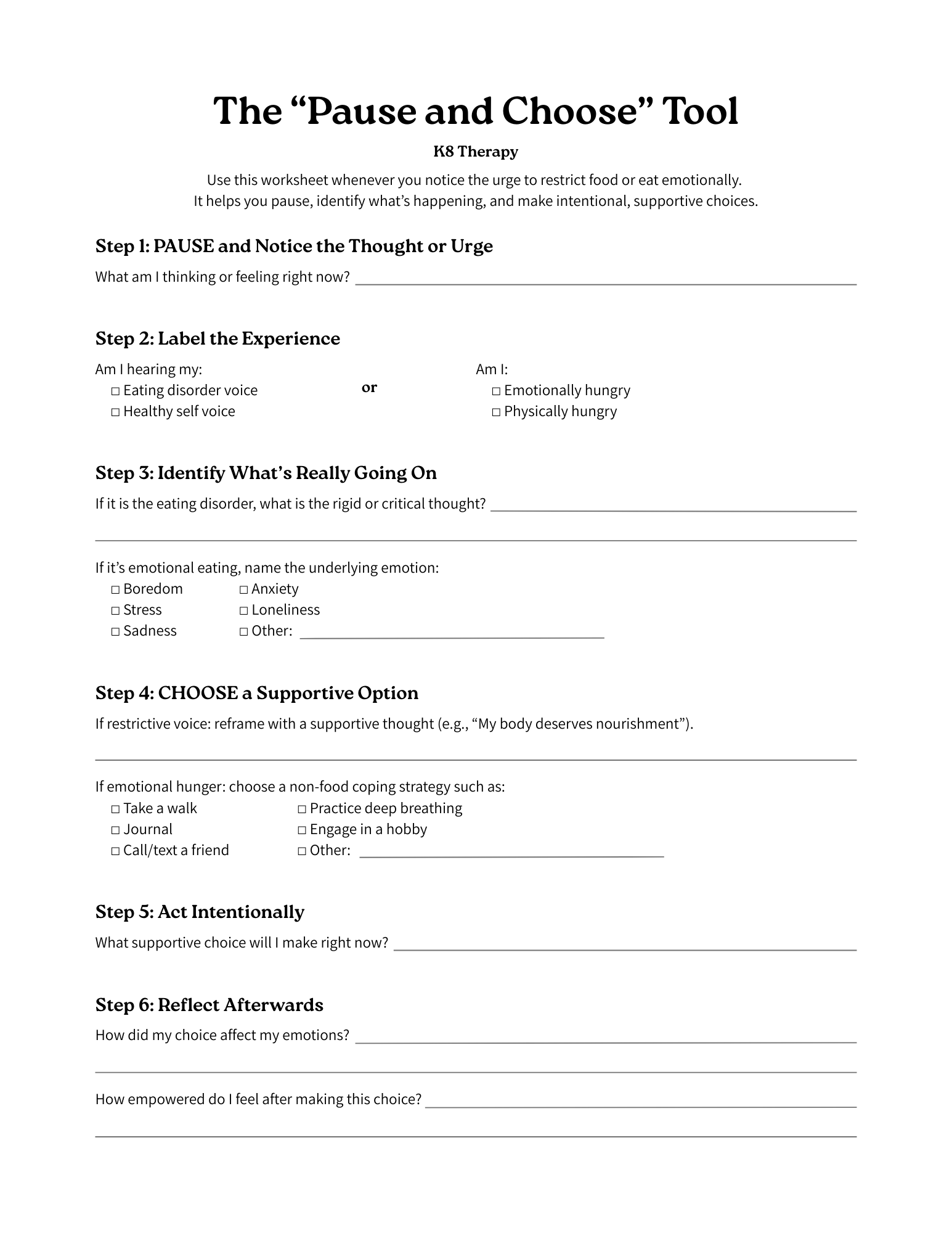The Power of Choice: How to Pause and Reframe Restrictive and Emotional Eating
At K8 Therapy, one of the most transformative lessons I teach is the power of choice in therapy. While it may sound simple, choice is at the heart of recovery from eating disorders and emotional eating. It’s about realizing that you have the ability to choose the thoughts and beliefs you act on—shaping your emotions, behaviors, and ultimately your healing journey.
For many people struggling with eating concerns, it can feel like thoughts and urges are automatic and absolute. The eating disorder voice may insist, “I can’t eat this meal” or “I’ll feel better if I restrict.” In emotional eating, the voice might say, “Food will make me feel less lonely” or “I need this to cope with stress.” Without awareness, it’s easy to react automatically and follow those patterns.
But when you pause, you create space to recognize that thoughts are not commands. That space gives you the opportunity to make a different choice—one that aligns with balance, nourishment, and self-compassion.
Reframing Restrictive Thoughts
In therapy, we often begin with reframing. Instead of immediately accepting a thought like “I shouldn’t eat this”, clients are encouraged to pause and ask: “Is this my eating disorder talking, or is this my healthy self?”
✨ A Note on the Word “Healthy”
I know that the word “healthy” can feel loaded or even triggering for many people who struggle with eating disorders. Diet culture and eating disorder thoughts often twist this word into something rigid, critical, or punishing. When I use “healthy” in therapy, I’m not talking about a certain body type, “good” or “bad” foods, or external rules. Instead, I use it in its most objective sense: thoughts and behaviors that genuinely support your well-being—physically, emotionally, and mentally. Part of recovery is reclaiming this word from the eating disorder and redefining it to reflect balance, care, and self-compassion.
That simple reframe—choosing the healthy self—creates a moment of choice. Clients can practice listening to the part of themselves that values nourishment, rest, and growth, rather than the critical voice that limits and restricts. Over time, consistently choosing this perspective strengthens it and builds lasting change.
Pausing in Emotional Eating
The same principle applies to emotional eating. When the urge to eat arises, pausing can help you distinguish whether the hunger is physical or emotional. Ask yourself: “Am I physically hungry, or am I emotionally hungry?”
If you’re physically hungry, the supportive choice is to nourish your body.
If you’re emotionally hungry, the next step is to identify the feeling underneath the craving—such as boredom, stress, sadness, or loneliness. Once the emotion is clear, you can choose an alternative way to address it, such as journaling, taking a walk, calling a friend, or practicing mindfulness.
This small but powerful pause transforms automatic urges into intentional decisions, giving you back a sense of control.
The “Pause and Choose” Tool
Here’s a practical way to use the power of choice whether you’re facing restrictive thoughts or emotional eating urges:
Notice the Thought or Urge – Pause when you hear the eating disorder voice or feel the urge to eat emotionally.
Label the Experience – Ask: “Is this my eating disorder voice or my healthy self?” OR “Am I physically hungry or emotionally hungry?”
Identify What’s Really Going On – If it’s restriction, notice the rigid or critical thought. If it’s emotional eating, name the underlying emotion.
Reframe the Option – Consider a new, values-aligned thought like “My body deserves nourishment” or “I can soothe boredom by calling a friend instead of eating.”
Choose Intentionally – Decide which option supports your overall well-being.
Reflect Afterwards – Notice how making a conscious choice affects your emotions and your sense of empowerment.
With practice, this exercise retrains the brain to recognize patterns, expand options, and strengthen values-aligned responses. Over time, the act of pausing and choosing becomes second nature.
Why This Matters
Whether you struggle with restrictive eating or emotional eating, the lesson is the same: thoughts and urges are not facts, and you have the power to choose how to respond. Each intentional choice builds empowerment, freedom, and confidence in your ability to change.
Recovery begins when you realize you are not at the mercy of automatic patterns—you have options. And with options comes hope.
Take the Next Step
Ready to start practicing the power of choice in your own life? Download the “Pause and Choose” worksheet to help you challenge restrictive thoughts, manage emotional eating, and make empowered decisions every day.
Or, book a session at K8 Therapy to learn personalized strategies, strengthen your healthy voice, and create lasting freedom from eating disorder patterns. Your healing starts with one choice—today.
